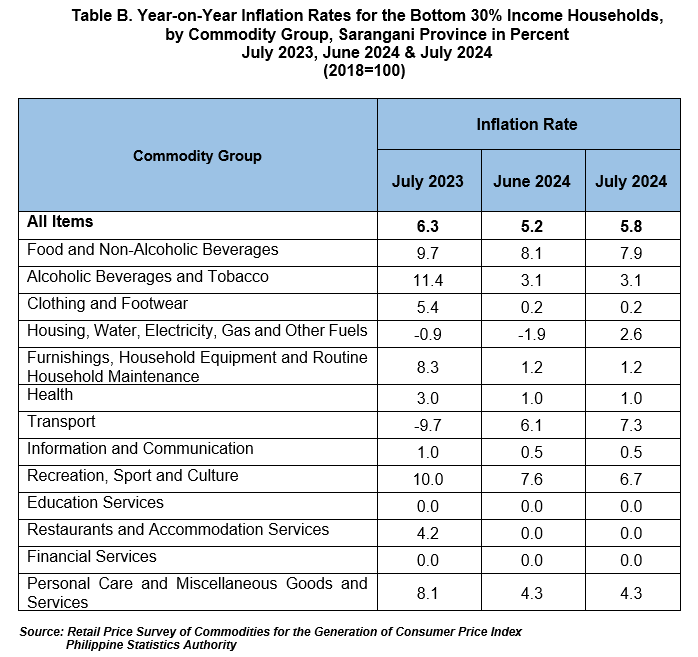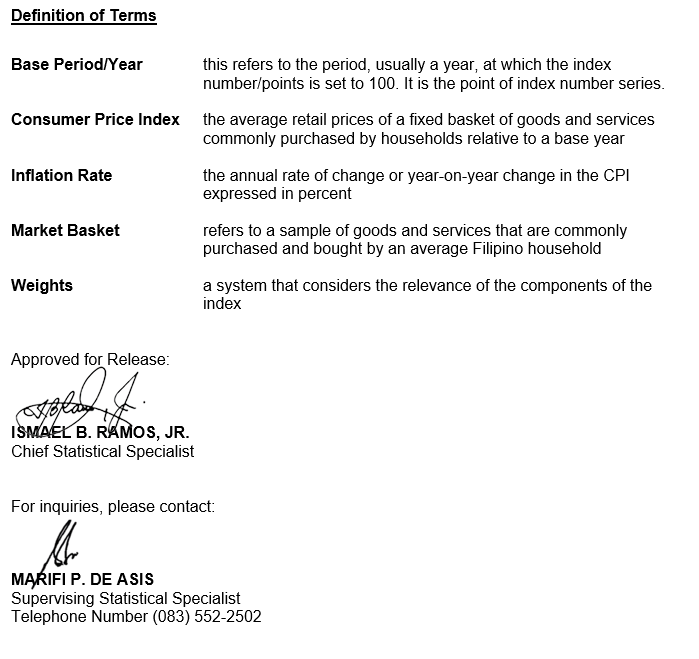
YEAR-ON-YEAR INFLATION RATES
The inflation or the annual rate of change on the prices of goods and services in the market basket for the bottom 30% income households or the low-income group in Sarangani Province escalated to 5.8 percent in July 2024 from last month’s inflation at 5.2 percent. This was higher than the regional at 5.4 percent and equal to national level at 5.8 percent. However, this was lower by 0.5 percentage points from a year ago of the same month at 6.3 percent. The average inflation or the year-to-date inflation of the province was recorded at 6.1 percent.

The two major contributors to the province’s uptrend inflation for the bottom 30% income households for the month of July 2024 were: Housing, water, electricity, gas and other fuels with 2.6 percent inflation from -1.9 percent which contributed 90.2 percent to the uptrend and transport with 7.3 percent inflation from 6.1 percent in the previous month. (Table B)
Meanwhile, food and non-alcoholic beverages and recreation, sports and culture showed a downward trend with 7.9 percent from 8.1 percent and 6.7 percent from 7.6 percent, respectively. (Table B)
The rest of the commodity groups: Alcoholic beverages and tobacco; clothing and footwear; furnishings, household equipment and routine household maintenance; health; information and communication; education services; restaurants and accommodation services; financial services; and personal care and miscellaneous goods and services maintained their previous month’s inflation rates. (Table B)

The contributors for the increased inflation in housing, water, electricity, gas and other fuels were electricity at 10.3 percent inflation in July 2024 from -16.6 percent in the previous month, which contributed 88.6 percent to the uptrend, gas contributed 0.7 percent with 5.8 percent inflation and security equipment and materials for the maintenance and repair of the dwelling with -2.3 percent inflation, which shared 0.6 percent. (Table C)

Meanwhile, Sarangani Province’s food inflation for the bottom 30% income households declined to 8.3 percent in July 2024 from 8.5 percent in June 2024. In June 2023, food inflation for the bottom 30% households was higher at 9.8 percent. (Table D)
The deceleration of food inflation for the bottom 30% income households in July 2024 was due to the decrease in the indices of the following:
a) Cereals and cereal products, 18.0% from 20.0%;
b) Fruits and nuts, 6.9% from 9.9%;
c) Ready-made food and other food products n.e.c, 10.5% from 12.4%
d) Meat and other parts of slaughtered land animals, -0.3% from 0.3%
e) Sugar, confectionery and desserts, -10.1% from -9.3%; and
f) Oil and fats, -3.2% from -2.5%.
In contrast, increased annual growth rates during the month were recorded in the indices of fish and other seafoods at -3.7 percent in July 2024 from -5.2 percent in the previous month. This was followed by milk, other dairy products and eggs at 2.7 percent in July 2024 from 2.6 percent in June 2024. Higher annual increments was also noted for vegetables, tubers, plantains, cooking bananas and pulses at 10.2 percent during the month from 6.1 percent in June 2024. (Table D)



